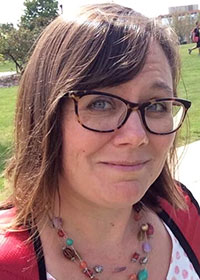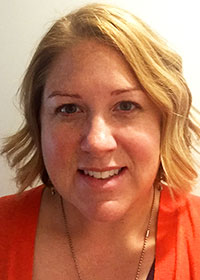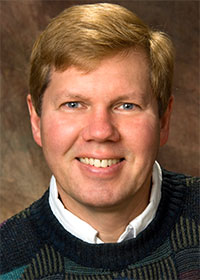
Angie Lobdell
Angie Lobdell knows her way around schools.
When her youngest child was born in 2001, she became a stay-at-home mom. And when that child began kindergarten, she maternally followed.
“I decided to work at the school. I got a job as a para,” Lobdell says. “Later I got a promotion to reading aide – or Title I aide – and I thought, ‘I’m already doing some lesson-planning, and I always wanted to finish college, so let’s just do it.’ ”

Heather Kerfoot
Heather Kerfoot found inspiration from one of her oldest son’s former teachers.
“Both of my sons, who are both teenagers, have special ed in their educational lives, and I have seen the great things it can do for students who really need it. I’ve seen it make a big change in their academic abilities and performance,” says Kerfoot, who lives in Naperville, IL.
“There’s one great teacher who really made a difference for my 17-year-old when he was an eighth-grader,” she adds. “In fact, he still communicates with this teacher, and I can’t say enough about what he did for us.”

Roxanne Espinoza
Roxanne Espinoza’s light-bulb moment came long before adulthood.
“I got the wonderful opportunity to do a Partners Club in junior high,” Espinoza says. “They pair you up with a student with a disability, and you do fun activities after school. I just enjoyed the experience. I helped students with disabilities with their homework, and I just loved that.”
Lobdell, Kerfoot and Espinoza have plenty in common.
All are majoring in special education. All are transfer students, from Sauk Valley Community College, the College of DuPage and Harper College, respectively.
And all recently earned one credit each in a new course called “Exploring the Special Ed Major,” now required for all students who declare the major.
“For years, everyone has talked about the quality and importance of recruitment and retention,” says Toni Van Laarhoven, Presidential Teaching Professor in the Department of Special and Early Education.
“In our program – in Special Ed – we’d say the problem was that we never get to reach the freshmen and sophomores and to pull them in to get to know our program until they were in their junior year and in the professional block,” she adds.
Van Laarhoven noticed that her licensure candidates in Block 3 (the semester immediately before they begin to student-teach) were largely unaware of amazing resources and opportunities they had all through their NIU careers: student organizations, the NIU College of Education’s Student Services, the Educate and Engage Program, undergraduate research and the Learning Center.
“But it was almost too late,” she says, “so we as a faculty started talking about, ‘What are the cool things we would like potential Special Ed majors to know?’ And we just developed this course.”
Coursework includes the making and keeping of one-on-one appointments with academic advisers and with Van Laarhoven herself, who taught the fall class one day a week in a blended face-to-face and online format.
Students learn about the structure of the program, including the professional blocks, as well as the requirements of getting in and staying in the major. They are told where to find more information on the Educator Licensure Test of Academic Proficiency (TAP) as well as tutoring, counseling and more.

Greg Conderman
They must complete “passport” activities such as locating faculty and departmental offices, meeting Department Chair Greg Conderman and conducting interviews with professors to learn about their academic backgrounds, their daily work and their research interests.
“We also do silly things,” Van Laarhoven says. “They have to go down to the Learning Center and take a selfie of themselves getting coffee. It’s like our best-kept secret: You don’t have to go to the library! There are a lot of things here that are fun.”
Beyond the basics, she says, the course offers comfort and early camaraderie.
“I tell students that we want them to feel like this is their home, and that they can come to any of us at any time,” she says. “They also have to write directions for how to go downstairs, how to find the advisers’ offices and all the way down to the little lounge in the basement of Graham Hall – ways to find all these places where they can belong.”
After piloting the program in fall 2017, the professor believes the department has earned a gold medal for innovation.
“I could see the students’ eyes lighting up, like, ‘Wow, I didn’t even know this was possible,’ or, ‘I’m feeling like I’m so connected already. It makes me feel like I belong,’ ” she says. “For me, it’s just plain fun. I’m even learning about my own peers by hearing some of the interesting facts that the faculty are telling the students.”
Espinoza, Lobdell and Kerfoot agree.
“You can have anxiety going from a community college straight into a four-year university, and especially into Special Ed, which is such a broad category,” says Espinoza, who is from Schaumburg, IL. “This helps you to look at what’s ahead in the program in terms of, ‘This is what I need to do. This is what I need to prepare for my future.’ ”
With an hour-long commute between campus and her home in Sterling, IL, Lobdell is grateful for being pointed to the free coffee and friendly study environment of the Learning Center. She also enjoyed meeting other transfer students.
“I was very nervous coming from my little community college to Northern; I was only doing that part-time and working full-time. I finally made the switch this fall,” she says, adding that most of her traditional-age classmates in other courses “weren’t really my peers. Having this class just made me more comfortable.”
Kerfoot, who formerly managed real estate for Hoffman Estates-based Sears Holdings Corp., calls Van Laarhoven “a great ambassador for the Special Education program.”
“Toni did a great job of getting us entwined in the department – who the professors are, who the head of the department is, meeting a professor and interviewing them, talking with Dr. Conderman,” she says.
“One thing I thought was really nice was that you get to meet people who also want to be in Special Ed,” she adds. “Special Ed is a lot more than helping out your kid at home, and if I can help somebody else’s kids the way my kids have been helped, I would love to be a part of that.”
Most of all, Kerfoot gained empowerment during her interview with Associate Professor Sarah Johnston-Rodriguez.
“She primarily works with transitional students between 18 and 21, and that’s something I’m possibly interested in but haven’t committed to yet,” Kerfoot says.
“And as a mom, and especially as a mom of kids who have special education and a disability, I’ve kind of struggled with the idea of, ‘I guess this is what I want to do, but how do I not want to take all these kids home with me?’ ” she adds. “Dr. Rodriguez told me, ‘You’re not there to feel sorry for them. You’re there to help them.’ That really spoke to me. That really made sense. That’s something I can take with me. And it kind of got me past that.”
